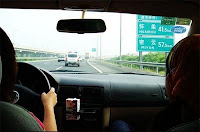- Always check the tires regularly check the tires before the road. Keep the air pressure in tires as recommended. The size of the right air pressure is determined by the vehicle manufacturer and can be read on the back side of the door, doorpost, glove box door or behind the fuel tank cap. These sizes can also be read in user manual. The numbers are printed on the tire wall is not the recommended air pressure for tires, but the maximum pressure for that tire. Check your tire air pressure at least once a month. Check the depth of the groove. Sufficient depth to avoid the cars skid (slip) or floating on water (aquaplaning).
- Reduce speed in rainy season, the water mixes with oil on the road surface and make the road surface becomes slippery and the tires slip easily. The best way to avoid the slip is to reduce speed. At lower speeds more groove tires come into contact with the road surface and traction will be better.
- Learning how to cope with Slip slip can occur even in the driver the most careful though. If the car begins to skid, do not ever step on the brakes out. Do not pump the brakes if the car is equipped with anti-lock braking system (ABS). Instead, press with a definite and direct steering in the direction of slip car.
- Keep your distance with the car in front of Driving in wet weather requires a subtle way of using the main control, steering, clutch pedals, brake and gas. When traveling in wet weather, boots may be too wet and can be slipped off the pedal. Rub the soles of shoes to rubber mats in the car before starting the engine. Every driver should always check headlights, taillights, brake lights and turn the sign lights (turn signal) everything works fine. On a wet road braking distances required three times longer than on dry roads. Because it takes a greater distance, do not stick to the car in front (tailgate). At least keep a distance twice the length of the car between the car in front.
- Follow the direction of the car in front Avoid using the brakes. If still possible, reduce speed by releasing the gas pedal. Turn on the headlights, although rain is not too heavy. These lights not only helps to see the road but also help other drivers see. If a car equipped with daytime running lights, in order to quicken the vehicle behind can see it better.
- Learn to avoid and overcome the cars floating on water (aquaplaning) aquaplaning occurs when the water in front of the assembled car tires more quickly than can be driven by the weight of the car. The pressure of the water lifted the car so that floated on the water that is between the tire and the road surface. At that time, the car will lose contact with the road surface, danslip or out of the lane. To avoid this situation, tire pressure should always be checked. Groove tires should also be deep enough. If necessary, the tire should be replaced. Slow down when roads are wet, and avoid puddles. Try to follow the trail left by tires on the front. If you feel the car floating on the water, do not brake or turn the wheel abruptly. This will make the car slip. Remove the stamping on the accelerator until the car speed is reduced and again felt the grip of the tires on the road surface. If the car is equipped ABS, stepped on the brakes as normal. Computers in the brake system will do its own pumping when necessary.
- If heavy rain, stopping just a heavy rain will burden glass wiper (wiper), so the windshield is always covered with water. When the outlook is very limited so can not see the limits of the road or other vehicles, it's a sign we should step aside and stop until the rain stopped. Look for a resort or other safe places. If forced to stop at the curb, stop to the edge once. Turn on headlights and hazard lights to create alert other drivers.
- Early rains make roads very slippery When the rain had just come down, usually the path becomes very difficult to control because of mud and oil on a dry road is now mixed with water and form a layer that is very slippery. Control of the car will be reduced, therefore the driver must be careful during the first half hour after it began to rain.
- Cloudy weather also reduces vision Take extra care when preceded by other vehicles. Dry your brakes after going through the puddles. After going through a puddle of water in your brakes and maybe wet, press the brake pedal a little dry.
- Stop driving when feeling very tired Stop every few hours or after several hundred miles to rest.
Friday, June 17, 2011
10 Easy and Safe Tips Car Driving
Driving safely is everyone's desire, the following tips are easy to be implemented
Labels:
car,
car tips,
safe driving
Subscribe to:
Post Comments (Atom)

I think while driving you should not use mobile phone because cell phone can take your focus away from driving and yes you made right point that you should keep your distance with the car in front of driving is important.
ReplyDeleteDriving School Worcester